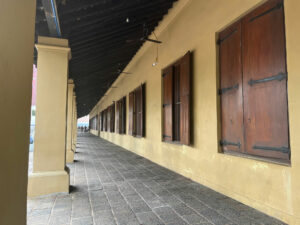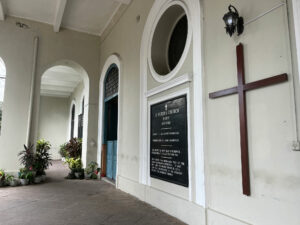Kedu
Slave Revolt or Bloody Murder? Inside the world of Kedu
The tragic history of Kedu and his companions brings back to life the history of slavery and violence under the Dutch. It tells how Kedu’s resistance against slavery later became the founding story of Colombo’s city quarter called Slave Island (Kompannavidiya/Company Street). Following the traces of Kedu’s crime and execution in Colombo offers us insight into the experiences of the enslaved, and the world they inhabited. By retelling this life story, we remember the life, exploitation, and resistance of enslaved people in Sri Lanka.
Slave Revolt or Bloody Murder? Inside the world of Kedu
On 8 June 1723 in Colombo, a group of young people between twelve and twenty-eight years old, committed a murder. Two murders, to be exact. How exactly it happened we do not know, but the murder was ‘brutal’ and ‘horrific’ by all accounts. The murdered: a Dutch prosecutor, Barent van der Swaan and his wife. The murderers: their enslaved servants. They were soon apprehended by the Dutch and confessed to the murder. Some prayed for forgiveness, others, like nineteen-year-old Lotty, asked for a merciful death: hanging.
For six of the twelve accused, there was no mercy, and the death penalty turned out to be particularly brutal. Kedu, twenty-three or twenty-four years old, was considered the leader of the group. His torturous public punishmentCorporal punishment was common in society at the time, and consisted of for example flagellation, branding and forced labour. More was dragged out, meant to scare off anyone who thought of following Kedu and his accomplices’ example in the murder of their masters.
This story is the origin of the legend about the name of slave island. The legend said that there was a revolt in Colombo by African slaves in 1723, and as a result all slaves living in Colombo were then banished to ‘slave island’. The only event resembling such a revolt in that year was the murder of Van der Swaan and his wife. But who was Kedu? And does his story really relate to the name of Slave Island?

Kedu was from Timor (Indonesia), where he had been bought by Van der Swaan. Before he moved to Colombo, Van der Swaan worked as a Company agent in Kupang, West Timor. In 1721, Van der Swaan was transferred, to work as a prosecutor (fiscaal ) in Colombo. He did not only move his wife with him, but also his enslaved servants: Kedu, Lotty and the others. The Van der Swaan household was on what is now Chatham Street, near the Old Dutch Hospital. Kedu was thus not African as the legend suggested, but from Southeast Asian descent.
Slave Island
In the period of Kedu’s life, 50% (around 1000 people) of the population living in and around Colombo fort was registered as a slave. The work of the enslaved was a necessary part of the day-to-day functioning of Dutch colonial society. There were different kinds of enslaved categories: privately owned, such as Kedu and Lotty, and the ‘Company’s lijfeigenen’, bonded people or slaves. The latter category were people owned by the Company and forced to work where necessary in the Colombo area.
Before 1700 the VOC lijfeigenen lived close to the port as well as the warehouses, outside of the western wall of Colombo, between the ocean and the wall, where currently the Lighthouse stands. From 1700 onwards, this place presumably had gotten too small or perhaps it was too prone to flooding.

Whatever the reason was, from then on many of the VOC ‘lijfeigenen’ lived at Slave Island or slaveneiland, as the Dutch then called it. In Sinhala the name was much more alike to the current name, referring to Kompanna or Company. Many slaves were rowed from the island to their work in the port or the city. The ferry was at the place where currently Kompannavidiya train station is. There was also a bridge between the fort and the island, near where currently Cinnamon Lakeside Hotel is.
Kedu had brought his religion from Timor with him: the court records tell us he was not Christian or Muslim. Generally, Malay was a common language spoken throughout the archipelago of current-day Indonesia: Van der Swaan and his wife probably spoke Malay to Kedu, Lotty and the others. Though Kedu probably spoke his own language with the others from Timor, enslaved people from the region, living in Sri Lanka, were known to speak Malay among each other too. As did Southeast Asian merchants, princely families, soldiers and others who would settle on Slave Island in the centuries that followed. The communities on Slave Island became a melting pot of languages, cultures and religions.
Slavery in 18th century Colombo
The experience of slavery in Sri Lanka in this period varied. Some worked for the Company, others in private households. Labour included heavy physical work on the roads and the Docks for the company, or in the (plantation like) gardens and around the house of the masters. The status of the enslaved was visible in the street: enslaved people were prohibited of wearing certain clothing, or shoes, and were punished with beatings and worse if they transgressed these rules. A free woman could not marry an enslaved man, and vice versa. The child of an enslaved person, whether it concerned an enslaved father or mother, would always be enslaved too. The enslaved were at the mercy of their masters, also when it concerned sexual advances: if a woman was lucky it could result in freedom for her or her children in the long term. Often, however, such encounters consisted of intimate violence – rape.
Kedu’s life in slavery had been terrible. In court, he and his accomplices declared that they had suffered under their masters’ hands, and that they had wanted to stop the abuse. The archival source here is minimal: information has either been lost or was not deemed relevant enough to mention. The enslaved servants might have known it would end badly for them, but perhaps also wanted to set an example and deter all the Dutchmen from further abusing their slaves. Either way, the Dutch were alarmed by the murder: given the number of enslaved people living in Colombo, they wanted to prevent an uprising at all cost.
Kedu’s act of despair
What the final straw was, is not clear. But after two years of living in Sri Lanka, Kedu and the other enslaved servants had apparently been so frustrated that they saw no other way than to murder both Van der Swaan and his wife. Had the slaves hidden in the master bedroom and killed them with a dagger (as happened in a similar case in 1799)? Or maybe they had attacked Van der Swaan while they were supposed to serve dinner or carry their master around the city?
Nonetheless, it had been a suicide-mission: Kedu and the others were soon apprehended. Kedu in particular was executed in a horrible manner. He was dragged around Colombo fort on a plank, scorched with fire, cut open alive and his beheaded head and limbs were carried around and put on a spike for days after. Kedu’s bodily remains were then scattered all over town.

Following the traces of Kedu’s crime and execution in Colombo offers us insight into the experiences of the enslaved, and the world they inhabited. Though to us the story of Kedu might have started with the violence of the murder, he himself was part of a violent system: taken as property, moved involuntarily to another part of the world, and forced to perform labour. By retelling this life story, we remember the life, exploitation, and resistance of enslaved people in Sri Lanka.
This story is based on the first chapter of Nira Wickramasinghe’s book ‘Slave in a Palanquin. Colonial Servitude and Resistance in Sri Lanka’ (2020). Published by Columbia University Press, New York. The Sri Lanka edition of the book is published under licence by Tambapanni Academic Publishers, Colombo.


